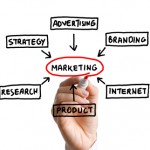What should You Spend on Advertising?

One of the questions I’m frequently asked is: “How much should my company spend on marketing and advertising?” It’s a conundrum that vexes many corporate leaders, from emerging entrepreneurs to seasoned CEOs. Unfortunately, instead of seeking a rational answer to the question, many of them just ignore it and hope it will go away.
As a rule, emerging companies focus most of their time and talents on meeting the needs of customers, as well they should. If they don’t take care of the customers they already have, everything else will be academic. Strangely, however, many neglect the function of winning customers in the first place. Others naively assume that if they simply provide excellent products or services, their reputation will precede them. Call it the “build a better mousetrap” syndrome. But the world has too many other things to do with its time than beat a path to your door. That means you need to structure your profit-and-loss statement in such a way that you can profitably allocate a reasonable percentage of your revenue to marketing.
The Big Question: How Much?
While there is no definitive answer as to how much any business should spend on marketing, there are general guidelines any company can use to develop a formula that works for them.
Your first step should be to try to find out what the advertising-to-sales ratio typically is in your field. Public companies in your industry may give a figure for their marketing spending in their financial statements (found in their annual reports). With a simple calculation, you can figure out what percentage of their overall revenue that represents. If you can’t find any public companies that seem similar enough to yours, you might want to start at 5% and then adjust your projected spending up or down based on the size of your market, the cost of media, what you can learn about how much your competitors are spending, and the speed at which you’d like to grow.
You’ll also need to ask yourself if your business is built to leverage volume or to leverage margin. Even within industries, there are substantial differences in the marketing spend of volume-driven companies compared with margin-driven ones. Volume-driven companies tend to spend a tiny percentage of sales on marketing, in part because their large revenues enable small contributions to add up fast, and in part because of the margin pressures they face in having to compete with other high volume companies. By contrast, margin-driven companies tend to spend a larger percentage of sales on marketing: They have room in their margins to afford it, and they’re often working from a smaller revenue base.
The retail industry provides some good examples. While Wal-Mart (WMT) might spend a meager 0.4% of sales on advertising, the sheer size of the company turns that tiny percentage into a significant budget. Wal-Mart’s nominally higher-margin competitor, Target (TGT), spends closer to 2% of its sales on advertising, while Best Buy (BBY), as a specialty retailer, spends upwards of 3%. Finally, more upscale stores like Macy’s typically spend on the order of 5%.
The same kind of ratios can be seen in the car industry (automakers’ generally spend 2.5% to 3.5% of revenue on marketing), liquor (5.5% to 7.5%), packaged goods (4% to 10%), and every other industry.
If you’re in a services business, you might want to bump your starting point higher than 5%. For example, like most professional services firms, my company is more margin-oriented than volume-oriented, so fueling its growth requires that we spend a higher percentage of our revenues. Last year, our number was just over 8%, and I’ve seen companies spend upwards of 15% when warranted—especially young companies that need to invest to build their brand.
Marketing, Not Just Advertising
It’s important to make a qualification here. Giant consumer corporations such as automakers, packaged food manufacturers, and retail chains spend a huge percentage of their marketing dollars on paid media advertising, the most visible (and expensive) tool in the marketing toolbox. Depending on the size of your company and the business you’re in, advertising might not be the right (and certainly not the only) tool for you.
A professional services company like my own is a good case in point. While we serve a national clientele, we are much too small to effectively advertise on a national scale. As a result, we don’t purchase paid media advertising. But we do have an aggressive marketing program built around tactics like direct mail, online marketing and public relations. For a variety of reasons, paid advertising might not be right for your company either, but events, vehicle wraps, point-of-sale displays, or other tactics certainly could be.
The important thing is intentionally and deliberately to set aside some rational percentage of your sales to get out there. That way, the question you have to answer isn’t “How much should we spend?” but rather, “How do we spend most effectively?”
By Steve McKee, president of McKee Wallwork Cleveland, a marketing consultant, author of When Growth Stalls: How it Happens, Why You’re Stuck, and What to Do About It.
Source: www.businessweek.com



